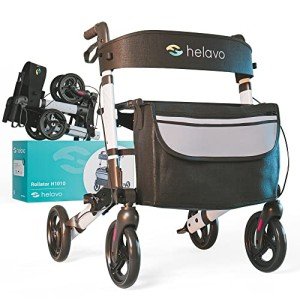20 Important Questions To Ask About Lightweight Rollator Walker Before You Buy Lightweight Rollator Walker
The Ultimate Guide to Lightweight Rollator Walkers
As people age or experience mobility obstacles, keeping self-reliance ends up being progressively essential. One of the most efficient mobility aids is the lightweight rollator walker. Combining function, convenience, and portability, these gadgets empower users to browse their environment with ease. In this detailed guide, we'll check out the features, advantages, types, upkeep, and answers to frequently asked questions about lightweight rollator walkers.
What is a Lightweight Rollator Walker?
A lightweight rollator walker is a mobility aid developed to provide support for people who might battle with balance or endurance when walking. This device features wheels, hand brakes, and a seat, enabling users to walk safely, take breaks, and navigate different surfaces. Its lightweight building makes it easy to transport, whether in a car or public transportation.
Key Features
When shopping for a rollator walker, it's important to understand the essential features that improve functionality and comfort. The following table lists common features related to lightweight rollator walkers:
Feature
Description
Weight Capacity
Most lightweight walkers support in between 250-350 pounds.
Wheels
Usually have four wheels for easy maneuverability on numerous surfaces.
Hand Brakes
Integrated hand brakes make sure safety and stability throughout use.
Height Adjustment
Numerous models provide adjustable deals with to accommodate users of various heights.
Seat
Offers a resting space for users, often padded for comfort.
Storage Basket
Allows users to bring individual items or groceries hands-free.
Folding Mechanism
Makes it possible for easy storage and transport when not in use.
Resilience
Made with high-quality materials to guarantee lasting use.
Advantages of Using Lightweight Rollator Walkers
Lightweight rollator walkers use various advantages to users, which include:
Increased Mobility: Users are less dependent on caretakers, permitting greater self-reliance and self-sufficiency.
Boosted Safety: The stability offered by the walker reduces the risk of falls and injuries during mobility.
Comfortable Design: With features like padded seats and ergonomic handles, users can feel comfortable while using the walker.
Convenience: Many designs include storage baskets or trays, making it easy to transport individual belongings.
Versatility: Suitable for both indoor and outdoor use, lightweight rollators can quickly browse sidewalks, corridors, and car park.
Types of Lightweight Rollator Walkers
Understanding the differences in between rollator walkers can assist users pick the ideal design for their needs. The following table details different types of lightweight rollators:
Type
Description
Standard Rollator
Basic design with four wheels, a seat, and hand brakes; ideal for the majority of users.
Three-Wheel Rollator
Lighter and more compact, excellent for tight areas however may offer less stability.
Heavy-Duty Rollator
Developed for users needing additional weight capability, often featuring larger seats.
Foldable Rollator
Compact design that folds quickly for transport; suitable for traveling.
Outdoor Rollator
Equipped with bigger wheels for rough or uneven terrain; great for outdoor activities.
Upkeep for Lightweight Rollator Walkers
To guarantee a long life-span and optimum performance, regular upkeep of the lightweight rollator walker is essential. Here are some useful upkeep ideas:
Check the Brakes Regularly: Ensure that the brake handles are functioning properly and change any worn parts.
Inspect Wheels and Tires: Check for wear and tear. Guarantee that the wheels spin freely without dragging versus the frame.
Tighten Up Bolts and Screws: Periodically check and tighten up any loose elements to maintain structural integrity.
Tidy the Frame: Wipe down the frame to remove dust or debris. Utilize a moist cloth with mild soap if necessary.
Lubricate Moving Parts: Apply lube to wheels and other moving joints which can assist avoid rust and ensure smooth operation.
FAQs about Lightweight Rollator Walkers
1. Are lightweight rollator walkers ideal for outdoor use?
Yes, lots of lightweight rollator walkers are created for both indoor and outdoor use. However, for outdoor activities, it might be best to pick a design particularly designed with larger wheels for much better maneuverability over numerous surfaces.
2. What is the weight limitation for lightweight rollator walkers?
Most lightweight rollator walkers have a weight capability in between 250 to 350 pounds. Make certain to inspect the manufacturer's specs, as it varies by design.
3. How do I understand which height modification is ideal for me?
A correct height adjustment is vital for comfort and safety. When standing directly, your elbows ought to be somewhat bent (about 15-30 degrees) while holding the handles. Seat height can also be considered for comfort during breaks.
4. Can I use a rollator walker if I have serious mobility restrictions?
Consulting with a health care expert is recommended to assess your particular requirements. Rollator walkers are designed for different levels of mobility, but it's important to figure out if they are proper for your condition.
5. How do I correctly fold a lightweight rollator walker?
To fold a rollator walker, guarantee it is on a flat surface. Locate please click the up coming website page folding mechanism (normally a lever or button) and gently pull or press it while simultaneously raising the handles towards you. This can differ by model, so refer to the user manual for specific directions.
Lightweight rollator walkers are indispensable tools for improving mobility, security, and self-reliance for users facing difficulties related to walking. With their numerous types and features, these walkers can accommodate a large spectrum of personal requirements, making it vital for users or caregivers to check out the alternatives available. Armed with proper maintenance methods and vital understanding, people can delight in the benefits of lightweight rollator walkers for years to come. Whether for everyday errands or a leisurely walk, these mobility help provide the support required to boost quality of life and promote independence.
